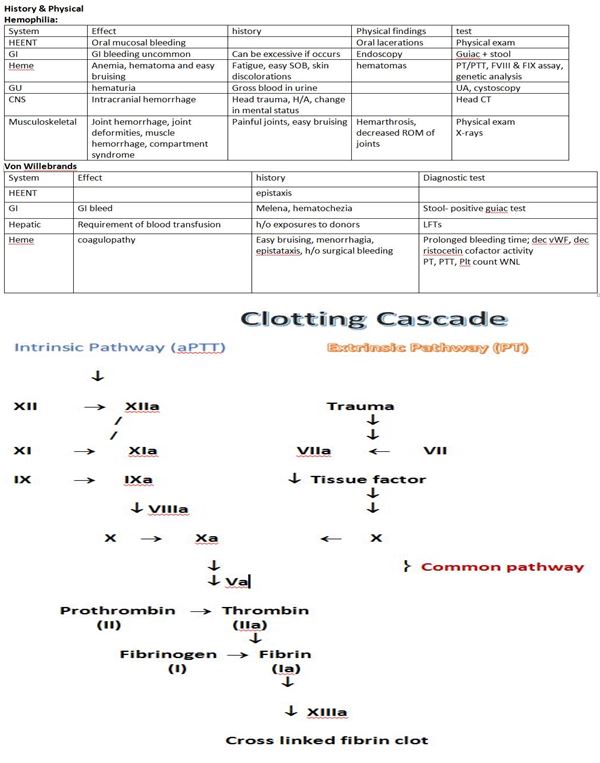[1]
Méndez Rojano R, Mendez S, Lucor D, Ranc A, Giansily-Blaizot M, Schved JF, Nicoud F. Kinetics of the coagulation cascade including the contact activation system: sensitivity analysis and model reduction. Biomechanics and modeling in mechanobiology. 2019 Aug:18(4):1139-1153. doi: 10.1007/s10237-019-01134-4. Epub 2019 Mar 21
[PubMed PMID: 30900051]
[2]
Sultan Y, Caen J, Bernard J. [Demonstration of recessive transmission in Willebrands diseases. Detection of heterozygotes]. Comptes rendus hebdomadaires des seances de l'Academie des sciences. Serie D: Sciences naturelles. 1974 Sep 23:279(13):1139-42
[PubMed PMID: 4219324]
[3]
Edlund M. [Menorrhagia--a symptom not sufficiently surveyed. The path to diagnosis and treatment lined with ambiguity and misunderstandings]. Lakartidningen. 2001 Nov 28:98(48):5505-6, 5509-10
[PubMed PMID: 11769366]
Level 3 (low-level) evidence
[4]
Kurth AA, Ludwig G, Scharrer I. [Prevalence, pathophysiology, diagnosis and treatment of von Willebrand syndrome in orthopedic trauma patients]. Der Orthopade. 1999 Apr:28(4):366-74
[PubMed PMID: 10335531]
[5]
Bertamino M, Riccardi F, Banov L, Svahn J, Molinari AC. Hemophilia Care in the Pediatric Age. Journal of clinical medicine. 2017 May 19:6(5):. doi: 10.3390/jcm6050054. Epub 2017 May 19
[PubMed PMID: 28534860]
[6]
Sholzberg M, Teitel J, Hicks LK. A 24-year-old woman with heavy menstrual bleeding. CMAJ : Canadian Medical Association journal = journal de l'Association medicale canadienne. 2017 Jun 5:189(22):E779-E780. doi: 10.1503/cmaj.161469. Epub
[PubMed PMID: 28584042]
[7]
Moon LM, Perez-Milicua G, Dietrich JE. Evaluation and management of heavy menstrual bleeding in adolescents. Current opinion in obstetrics & gynecology. 2017 Oct:29(5):328-336. doi: 10.1097/GCO.0000000000000394. Epub
[PubMed PMID: 28858896]
Level 3 (low-level) evidence
[8]
Karaman K, Akbayram S, Garipardıç M, Öner AF. Diagnostic evaluation of our patients with hemophilia A: 17-year experience. Turk pediatri arsivi. 2015 Jun:50(2):96-101. doi: 10.5152/tpa.2015.2516. Epub 2015 Jun 1
[PubMed PMID: 26265893]
[9]
Yoo MC, Jeong BO, Ahn J. Anterior osteophyte resection of the ankle joint to increase range of motion in haemophilic ankle arthropathy. Haemophilia : the official journal of the World Federation of Hemophilia. 2019 May:25(3):e159-e164. doi: 10.1111/hae.13719. Epub 2019 Mar 13
[PubMed PMID: 30866148]
[10]
Demers C, Derzko C, David M, Douglas J. No. 163-Gynaecological and Obstetric Management of Women With Inherited Bleeding Disorders. Journal of obstetrics and gynaecology Canada : JOGC = Journal d'obstetrique et gynecologie du Canada : JOGC. 2018 Feb:40(2):e91-e103. doi: 10.1016/j.jogc.2017.11.036. Epub
[PubMed PMID: 29447730]
Level 2 (mid-level) evidence
[11]
Neutze D, Roque J. Clinical Evaluation of Bleeding and Bruising in Primary Care. American family physician. 2016 Feb 15:93(4):279-86
[PubMed PMID: 26926815]
[12]
Jain S, Acharya SS. Management of rare coagulation disorders in 2018. Transfusion and apheresis science : official journal of the World Apheresis Association : official journal of the European Society for Haemapheresis. 2018 Dec:57(6):705-712. doi: 10.1016/j.transci.2018.10.009. Epub 2018 Oct 30
[PubMed PMID: 30392819]
[13]
Saif MA, Thachil J, Brown R, Bigger BW, Wynn RF, Nash M, Hay CR. Is it congenital or acquired von Willebrands disease? Haemophilia : the official journal of the World Federation of Hemophilia. 2015 Jan:21(1):e113-5. doi: 10.1111/hae.12588. Epub 2014 Nov 7
[PubMed PMID: 25381916]
[14]
Anzengruber J, Lubich C, Prenninger T, Gringeri A, Scheiflinger F, Reipert BM, Malisauskas M. Comparative analysis of marketed factor VIII products: recombinant products are not alike vis-a-vis soluble protein aggregates and subvisible particles. Journal of thrombosis and haemostasis : JTH. 2018 Jun:16(6):1176-1181. doi: 10.1111/jth.14125. Epub 2018 May 11
[PubMed PMID: 29665242]
Level 2 (mid-level) evidence
[15]
Guddati AK, Rosovsky RP, Van Cott EM, Kuter DJ. Quantitative analysis of desmopressin (DDAVP) response in adult patients with type 1 von Willebrand disease. International journal of laboratory hematology. 2019 Jun:41(3):325-330. doi: 10.1111/ijlh.12978. Epub 2019 Feb 8
[PubMed PMID: 30735311]
[16]
Barinsky GL,Buziashvili D,Svider PF,Carron MA,Folbe AJ,Hsueh WD,Eloy JA,Johnson AP, Perioperative Desmopressin for Patients Undergoing Otolaryngologic Procedures: A Systematic Review. Otolaryngology--head and neck surgery : official journal of American Academy of Otolaryngology-Head and Neck Surgery. 2019 Jul
[PubMed PMID: 30857487]
Level 1 (high-level) evidence
[17]
Kruse-Jarres R, Johnsen JM. How I treat type 2B von Willebrand disease. Blood. 2018 Mar 22:131(12):1292-1300. doi: 10.1182/blood-2017-06-742692. Epub 2018 Jan 29
[PubMed PMID: 29378695]
[18]
Miesbach W, Krekeler S, Wolf Z, Seifried E. Clinical use of Haemate® P in von Willebrand disease: a 25-year retrospective observational study. Thrombosis research. 2015 Mar:135(3):479-84. doi: 10.1016/j.thromres.2014.12.017. Epub 2014 Dec 27
[PubMed PMID: 25595881]
Level 2 (mid-level) evidence
[19]
Ockelford PA,Lowe G,Johns AS,Berry EW, Comparison of methods of plasma volume determination for dose calculation of factor VIII in patients with classic haemophilia. The New Zealand medical journal. 1986 Feb 26
[PubMed PMID: 3081842]
[20]
Bar-Natan M, Hymes KB. Management of Intraoperative Coagulopathy. Neurosurgery clinics of North America. 2018 Oct:29(4):557-565. doi: 10.1016/j.nec.2018.06.007. Epub
[PubMed PMID: 30223968]
[21]
Engelen ET, Schutgens RE, Mauser-Bunschoten EP, van Es RJ, van Galen KP. Antifibrinolytic therapy for preventing oral bleeding in people on anticoagulants undergoing minor oral surgery or dental extractions. The Cochrane database of systematic reviews. 2018 Jul 2:7(7):CD012293. doi: 10.1002/14651858.CD012293.pub2. Epub 2018 Jul 2
[PubMed PMID: 29963686]
Level 1 (high-level) evidence
[22]
Asensio JA,Cáceres ARR,Pelegrina LT,Sanhueza MLÁ,Scotti L,Parborell F,Laconi MR, Allopregnanolone alters follicular and luteal dynamics during the estrous cycle. Reproductive biology and endocrinology : RB
[PubMed PMID: 29636114]
[23]
Hamilton A, Ozelo M, Leggo J, Notley C, Brown H, Frontroth JP, Angelillo-Scherrer A, Baghaei F, Enayat SM, Favaloro E, Lillicrap D, Othman M. Frequency of platelet type versus type 2B von Willebrand disease. An international registry-based study. Thrombosis and haemostasis. 2011 Mar:105(3):501-8. doi: 10.1160/TH10-08-0523. Epub 2011 Feb 8
[PubMed PMID: 21301777]

